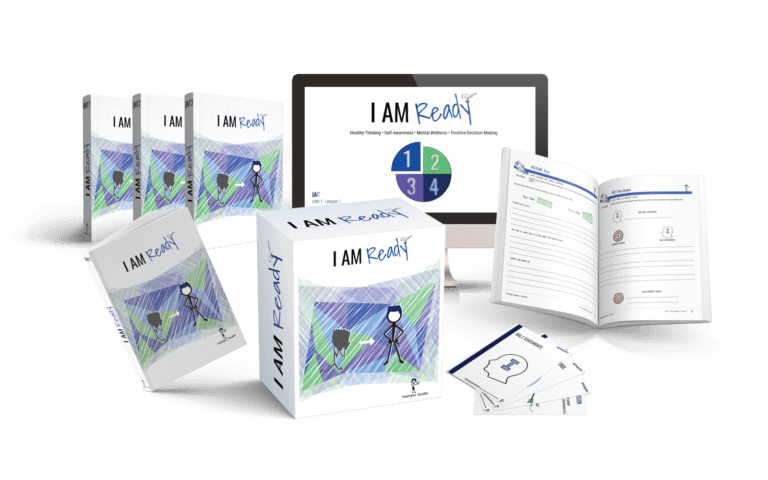Teach · Coach · Mentor

I AM READY
Curriculum
I AM READY

Unit 7: Who Controls Your Anger?
Guiding Questions:
- What is anger management?
- What is my style of anger management?
- Is it healthy?
- How can I manage anger assertively without resulting to aggression?
- What is respect?
- How can I manage anger to preserve the dignity and respect of myself and others?
Unit Description:
Anger is the emotional response that we have to internal or external events that are perceived as a threat, violation, or an injustice. Anger management is how we process, handle, and respond to our anger. Becoming angry is a natural and normal human reaction; however, how we perceive, manage, and respond to anger is a learned response.
In Unit 7, learners examine anger management styles and learn tools to improve their management and accept more self-control in emotionally tense situations. Learners explore the difference between assertiveness and aggressiveness and the concept of respect and dignity.
In this unit, students take an inventory of their Anger Management Style preferences, create an Anger Management Plan and learn how to use the ASSERT tool and the SELF tool to manage anger and communicate with respect and dignity during moments of anger and volatility.
Lesson Overviews
Lesson One
Overview
Learners define anger and explore Anger Management Styles and the concept of assertiveness. Learners are introduced to the ASSERT tool and examine how one learns anger management strategies. Learners review and create TRY Goals and discuss highs and lows with their Accountability Partners.
Critical Activities
- Take A Stand
- Accountability Partners
- Climb Our Mountain
- Rules for Living
- Transformation Circle
- Whip Around
Objectives
- Define Rules for Living
- Understand how Rules for Living are formed and applied
- Define Forces of Distortion
- Understand cognitive distortions
- Acknowledge challenges and successes
- Review and evaluate progress for personal records
- Set a TRY Goal
Learning Targets
- Define Rules for Living
- Understand how Rules for Living are formed and applied
- Define Forces of Distortion
- Understand cognitive distortions
- Acknowledge challenges and successes
- Review and evaluate progress for personal records
- Set a TRY Goal
Lesson Two
Learners explore self-control challenges and establish their WHY for course participation. This Happened! and Tracking My Day Tools reflective tools are introduce
Overview
Learners explore aggressiveness and assertiveness, practice applying the ASSERT tool and the START tool. Learners create an anger management plan.
Critical Activities
- Words I Wish I Wrote
- Tie it Together
- RFL Cycle Walk
- This Happened!
- Tracking My Day
- A Picture Speaks a Thousand Words
Objectives
- Understand how Rules for Living are developed
- Connect Rules for Living to internal events
- Identify thoughts, behaviors, and actions of others through roleplay
- Challenge cognitive distortions with Six Seconds to Ready
Learning Targets
- My RFLs influence my experiences. My experiences reinforce my RFLS.
- The RFL Cycle creates a powerful mental habit that impacts all aspects of my daily life.
- Distorted RFLs create distorted and irrational thoughts.
Lesson Three
Overview
Learners explore stress management through Today & Tomorrow Episode 7, complete the Empathy Map, and practice a guided meditation.
Critical Activities
- Tie it Together
- Tune in! Today & Tomorrow
- T&T Draw it!
- This Happened!
- Tracking My Day
- Back-to-Back
Objectives
- Identify thoughts, behaviors, and actions of others through story
- Identify I AM Ready tools for specific situations and scenarios
- Practice applying tools to characters in story
Learning Targets
- Targets and Statements are reviewed in the Transformation Circles and Accountability Partners.
Lesson Four
Overview
Learners examine the concept of respect and explore the SELF Tool for Dignified Voice.
Critical Activities
- Whip Around
- Free Throw Game
- Take a Stand
- Transformation Circle
- Accountability Partners
- Create a TRY Goal
- A Picture Speaks a Thousand Words
Objectives
- Review inner voice
- Identify thoughts, behaviors, and actions of others through story
- Practice challenging cognitive distortions with Six Seconds to Ready
- Build positive internal scripts
Learning Targets
Targets and Statements are reviewed in the Transformation Circles and Accountability Partners.
CBT Terms & Tools
Terms:
- Rules for Living
- Daily Rules for Living
- Protective Rules for Living
- Distortion
- Distress
- Trauma
- Chronic Stress
IAR Tools:
- This Happened! event journal
- Tracking My Day record
- Learning Targets
- Big I Statements
- ‘Above the Bar’ behaviors
- ‘Below the Bar’ behaviors
- Climb Our Mountain journal
- RFL Cycle Walk
- Six Seconds to Ready
